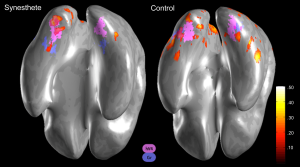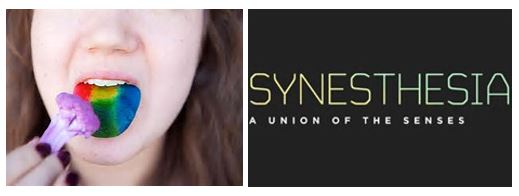Do you regularly perceive sweetness when listening to Beethoven? And does it happen every time? You may be a Synesthete!

So you probably do not experience tastes or flavors directly from Beethoven, but a Synesthete may. It might even be more likely if they listened to Beethoven’s sonatas in their early childhood, which is one suggested cause of synesthesia associations. So what exactly is this sensory meteorite I just dropped? Courtesy of Ancient Greek: [SYN] means together, and [AISTHESIS] means sensation, so sensations together!

In other words, it is a neurological phenomenon resulting from the stimulation of one sensory or cognitive pathway leading to automatic experiences in a second sensory or cognitive pathway. Could you be a Synesthete? It is hard to say, unless of course you are constantly experiencing patterned dual sensations. The likelihood of experiencing any form of synesthesia is not agreed upon among researchers. Some claim chances of this are 1:2,000, 1:300 or even 1:23, which is highly debated due to many forms being undocumented (Ramachandran and others 2001).
There are people that experience the so-called “Lexical-gustatory” version of synesthesia, which is one of the rarest forms of this neurological experience. Other types of synesthesia often combine spatial, color, and numerical relationships, but those with the notoriously infrequent lexical-gustatory synesthesia find that they experience particular tastes or flavors when hearing certain words, phrases or voices. CAN YOU IMAGINE?
The word “lederhosen” could immediately induce the perception of ice cream with sprinkles.

It is often that specific words, known as, inducers, create gustatory perceptions, or concurrents. One case study reported a person’s lexical-gustatory experiences were often linked to childhood anecdotes and experiences with unique foods (Richer and others 2011). For example, since experiences were often connected to childhood memories, coffee and alcoholic beverages were not reported as concurrents. When the word, “Barbie” was uttered, ‘sweet jelly with sour granules’ was perceived. When the French word for nightmare, “cauchemar” was pronounced, ‘fish sticks and stomach ache’ were experienced. “Squirrel” initiated the perception of sweet fruit juice and a salty taste.
Through these experiences it is easy to understand why this phenomenon might be induced via childhood experiences since they are fairly specific and unique. This is also a time of major brain plasticity, where learning and connections are consistently being made. Certain voices induced different gustatory concurrents, like Beyonce and celery water (poor Beyonce), as well as Rhianna and uncooked ramen noodles (Richer and others 2011). I assure you I am not making this up…

On the flip side, some flavors evoked words as well. Associations with smells of foods were less apparent, but this case did report the smell of soap evoking the word Billy (a brand of soap). Not all concurrents result in positive sensations and/or perceptions. For example, the tactile sensation of excrement and urine are also evoked by particular words for one case. Hmmm… that might not be so pleasant. One case claimed he became irritated because his sensations make concentration so difficult (Ward and Simner 2003).
There are other documented cases reporting colors and/or shapes promoting tastes as well, which are equally intriguing (Bleuler and Lehman 1881; Cytowic 1993; Calkins 1895; Downey 1911). Imagine tasting a color! That gives a whole new meeting to tasting the rainbow…

So what is this caused by? This is also debated. There is discussion of cross-talk between brain regions. Also, disinhibited feedback or lacking efficient communication among brain pathways, could also contribute to these experiences (Grossenbacher and Lovelace 2001). This altered wiring of the brain is also described as a partial failure of synaptic pruning (childhood learning processes often culminating at sexual maturity), resulting in exceptional connectivity among brain regions (Maurer 1993). There have also been reported synesthesia symptoms after trauma, like a stroke (Fornazzari and others 2012).
There are neural imaging techniques, specifically functional magnetic resonance imaging (fMRI), that have shown how critical regions of the brain become activated simultaneously supporting the described scenarios (Nunn and others 2002). Also replicated memory tests were performed for these associations showing results that were highly consistent and statistically significant among a cohort of control subjects as well (Ward and Simner 2003).

This image from Hubbard and others (2005) shows Syesthete’s brain activation in the color-sensitive region responding to black and white letters and numbers, while the control does not. Albeit this is not a showing of lexical-gustatory synesthesia, but the same idea parallels well in describing how words and tastes may be simultaneously sensed and perceived.
Our world is full of experiences and there is clearly not just one way to perceive them. You can have your cake and eat it too, at maybe just a drop of a word. You might not even need the cake.
References
Fornazzari L, Fischer CE, Ringer L, Schweizer TA (2012) “Blue is music to my ears”: Multimodal synesthesias after a thalamic stroke. Neurocase 18:318-322
Grossenbacher PG, Lovelace CT (2001) Mechanisms of synesthesia: cognitive and physiological constraints. Trends Cogn Sci (Regul Ed ) 5:36-41
Hubbard EM, Arman AC, Ramachandran VS, Boynton GM (2005) Individual differences among grapheme-color synesthetes: brain-behavior correlations. Neuron 45:975-985
Maurer D (1993) Neonatal synesthesia: Implications for the processing of speech and faces. In: Developmental neurocognition: Speech and face processing in the first year of life. Springer, pp 109-124
Nunn JA, Gregory LJ, Brammer M, Williams SC, Parslow DM, Morgan MJ, Morris RG, Bullmore ET, Baron-Cohen S, Gray JA (2002) Functional magnetic resonance imaging of synesthesia: activation of V4/V8 by spoken words. Nat Neurosci 5:371-375
Ramachandran VS, Hubbard EM (2001) Synaesthesia–a window into perception, thought and language. Journal of consciousness studies 8:3-34
Ward J, Simner J (2003) Lexical-gustatory synaesthesia: linguistic and conceptual factors. Cognition 89:237-261






Leave a Reply